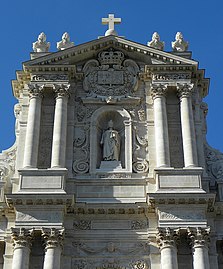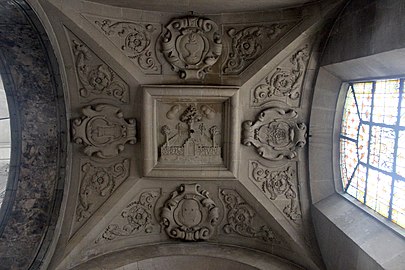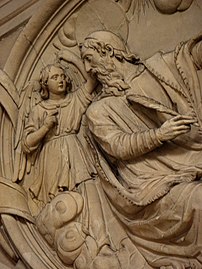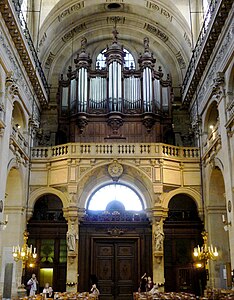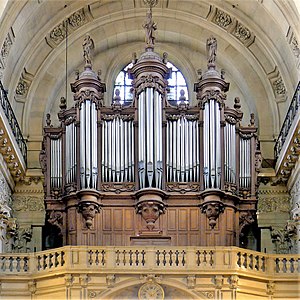Saint-Paul-Saint-Louis
| Église Saint-Paul-Saint-Louis | |
|---|---|
Paris |
The Église Saint-Paul-Saint-Louis is a church on rue Saint-Antoine in the
History
First church
The first church on the site, Saint-Paul-des-Champs, was dedicated around 1125,

Behind it was a cemetery, originally connected to the monastery of Saint-Éloi, founded by monks of
17th century -the new church

In 1580 the

The first mass was celebrated in the new building on 9 May 1641 (the feast of the Ascension) by
The new church became famous for its music; the musical directors included Marc-Antoine Charpentier et Jean-Philippe Rameau.[6]
The Jesuit priests became the confessors or "directors of conscience" of the Kings of France.
18th-19th century
In 1762, after a dispute with the King, the Jesuits were expelled from France by the
During the French Revolution, on 2 September 1792, 5 priests were killed in the church during the September Massacres. They are commemorated with a plaque. The church was closed and turned into a storehouse and a temple of the Cult of Reason and the Supreme Being before being restored to Catholicism in 1802 under the Concordat of 1801.
Delacroix painted Christ in agony on the Mount of Olives for the church, which until recently could be seen to the left of the altar. The church is currently displaying a placeholder as the original is on a long-term loan to the Metropolitan Museum of Art in New York City.[8] The church also displays La vierge del Douleur by Germain Pilon (1586). On one pillar on the right side of the nave is a nearly-erased inscription 'République française ou la mort' (French Republic or death), probably dating to the Paris Commune of 1871.
Exterior
The façade was clearly influenced by the new Italian
It uses Corinthian columns on the two lower levels and composite order. The dome was an unusual feature for a Jesuit building; both the dome and bell tower, fifty-five meters high, are largely hidden from view from the street by the very high façade. Another notable influence was the Flemish Baroque style, more lavish than the Italian style, seen in the abundance of sculpture and ornamant covering the façade.[9]
The dome of the church is 55 meters high, and was one of the first to be constructed in Paris. It served as a model for other domes, including those of
-
The north façade
-
Detail of the upper north façade
-
View of the apse and dome from the south
-
The Charlemagne Fountain, at the south end of the church
Interior
The interior design was largely inspired by the
The architectural historian André Chastel wrote: "the Jesuit order, even while recommending certain aspects, was attentive to local traditions."[10] Its plan is a compromise between the Gesu's single nave flanked by side chapels and the traditional French cruciform plan, as seen in its long transepts. The tall windows in these prominent transepts and the short eastern apse allow in large amounts of light, and the dome under the crossing also recalls Italian architecture of a slightly earlier period, such as that of Carlo Maderno.

The white marble high altar was moved and rebuilt under
-
The nave, facing the altar
-
The dome and the apse
-
Seashell benetier donated by Victor Hugo
Art and Decoration
Stained glass
-
white stained glass to maximize light
-
Coat of arms of the De la Porte family
-
Detail of the stained glass
Following the Baroque fashion, most of the stained glass in the windows was white, to bring a maximum of light into the church. Many of the windows were decorated with the coat-of-arms of the family that donated the window
Sculpture
-
"Saint Genevieve" on north façade
-
"The Virgin of Sorrow" by Germain Pilon (1588)
-
"Religion instructing an Indian", by Nicolas-Sébastien Adam (1745)
-
"Saint Vincent de Paul"
-
"Saint Paul", on north façade
In addition to the free-standing sculptures on the facades and interior, the pendentives of the dome and other interior architecture have their own lavish sculpture. There are very few surfaces inside the church without some sort of sculpture.
-
Pendentive of the dome
-
Decorated vaults of the nave
-
Sculpture in a ceiling vault
-
Interior sculpture below the dome
-
"Saint Paul Preaching in Athens", Bas-relief by Louis-Alexandre Romagnesi (1776-1852)
-
Sculpture below the dome
-
Decoration of a column capital
Painting
-
"Saint Louis receives the Crown of Thorns from the hands of Christ" by Simon Vouet, (1639)
-
"Christ in the Garden of Olives" by Eugène Delacroix (1827) (on loan to Metropolitan Museum)
-
"The Death of Saint Louis" by Jacques de Létin
The church displays several notable paintings from the 17th century. A series of three paintings depicts scenes from the life of Louis IX, or Saint Louis, for whom the church named. The fourth of the series has disappeared.
- "Louis XIII offering to Saint Louis a model of the Church Saint-Louis", attributed to the workshop of Simon Vouet, located in the right transept.
- "The Death of Saint Louis", by Jacques de Létin (1597-1661), also in the right transept.
- "Saint Louis receiving the Crown of Thorns from the hands of Christ" by Michel Corneille the Elder (1601-1664) Corneille was a pupil of Simon Vouet.
Another notable work in the left transept is "Christ in the Garden of Olives" by
The painting of the "Death of Saint Louis" by Jacques de Létin shows the King, stricken with the plague, being given the holy sacrmaents before his death. The figure on the left, face almost hidden by drapery, has the features of the artist.[12]
The Organs
The Gallery Organ
-
The gallery pipe organ
-
Detail of the pipe organ
During the Revolution, when the church was secularized, the existing gallery organ was dismantled and lost. After reconsecration, the organ builder Pierre Dallery used components from two other instruments to install a three-manual, 30-stop organ in 1805.[13]
After some sixty years, in 1867 the administration of the church hired Narcisse Martin, of Rouen, to make modifications to the organ case and to completely restore the instrument at a cost that reached 37,000 francs. This work was completed in 1871 and the organ was approved by César Franck, among others. The case has been designated as an historical monument.
A century later the firm of Gonzalez undertook a major tonal restructuring of the instrument along neo-classical lines, revoicing the pipes while also electrifying the action. This work was completed in 1972. These tonal changes were later reverted in two stages, 1999 and 2005, restoring Narcisse Martin's concept, but also providing a more Romantic-styled Récit manual. The organ acquired an electronic combination system as well.
The current instrument has three manuals with a compass of 56 notes, plus a 30-note pedal board, and consists of 40 stops and 46 ranks.
The Chancel Organ
The organ in the chancel was built in the nineteenth century by Krischer as a two-manual plus pedal mechanical action instrument. It comprises 13 stops and 16 ranks. Like the gallery organ, the manuals have a compass of 56 notes, with 30 notes in the pedal.[14]
See also
References
- ^ a b "Paroisse Saint Paul Saint Louis | Saint Paul". Paroisse Saint Paul Saint Louis (in French). Retrieved 2018-08-04.
- ^ "Église Saint-Paul Saint-Louis du Marais", Office de Tourisme de Paris
- ^ "Maison professe Saint-Louis des Jésuites, Paris : plan et critique par Martellange du projet de façade du P. Derand" (in French). Bibliothèque nationale de France.
- ^ a b Dumoulin, "Eglises de Paris", (2010), p. 82
- ^ "Church of Saint-Paul Saint-Louis", Religiana
- ^ Dumoulin, "Églises de Paris", (2010), p. 84
- ^ Ranum, Patricia M., "Marc-Antoine Charpentier compositeur pour les Jésuites (1687–1698)", Marc-Antoine Charpentier, un musicien retrouvé (Catherine Cessac, ed.), Sprimont: Mardaga, 2005, pp. 231–46
- ^ "Christ in the Garden of Olives", The Met
- ^ a b c d Dumoulin, "Églises de Paris", p. 83 (2010)
- ^ (in French) André Chastel
- ^ Dumoulin, "Églises de Paris" (2010), p. 84
- ^ Dumoulin, "Églises de Paris" (2010), p. 84
- ^ "Église Saint-Paul-Saint-Louis, Paris, France". Retrieved 2022-07-27.
- ^ "Les orgues de Paris". Retrieved 2022-07-27.
Bibliography (in French)
- Dumoulin, Aline; Ardisson, Alexandra; Maingard, Jérôme; Antonello, Murielle; Églises de Paris (2010), Éditions Massin, Issy-Les-Moulineaux, ISBN 978-2-7072-0683-1
- Hillairet, Jacques; Connaissance du Vieux Paris; (2017); Éditions Payot-Rivages, Paris; (in French). ISBN 978-2-2289-1911-1
External links
- (in French) The first Jesuit church in Paris
- (in French) Église Saint-Paul-Saint-Louis on .evous
- (in French) Les orgues de Paris Grand organ - specifications and photo
- (in French) Les orgues de Paris Choir organ - specifications and photo


